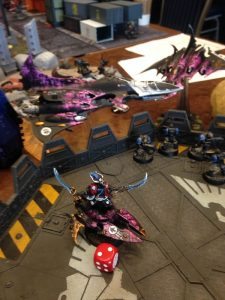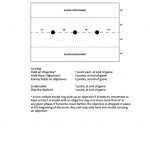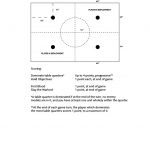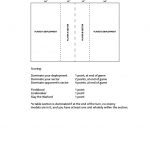Hey guys, it’s Adam from RUMBL and TheDiceAbide. It’s no secret that since I’ve become involved in the Infinity community, my interest in competitive 40k has waned significantly.
Game mechanics aside (people have their preferences) a big reason for this has been the way competitive Infinity is played, compared to competitive 40k. Infinity has something called the ITS, the Infinity Tournament System, which is a massive feat of community tournament support, far beyond what any other game publisher has done. It consists of army builder, tournament organization and recording software, as well as a PDF document outlining the various scenarios and exactly how to run an Infinity tournament. That document, the formats it outlines and the scenarios it supports are really what sets Infinity leaps and bounds ahead of many other games, in terms of viability for solid competition.
Official Formats
ITC 40k was created by the guys over at Frontline Gaming (likely where you’re reading this article!), all of which are veterans of many years of 40k, with the intention of making a flexible format, that promotes a common language and interpretation of rules in the 40k community. Despite the desire to have this flexibility, it would seem that tournaments deviate from the standard ITC scenarios and army construction rules. On the other hand, when you’re playing Infinity tournaments, it feels like no two are the same with a wide variety of requirements from army construction and scenarios. Some of these variables include:
- Are Spec Ops allowed? (A single, highly customizable unit in your army)
- Is it Direct Action, Joint Operations or Special Operations? (refers to which pool of scenarios to play, but broadly means few, moderate or many objectives)
- Is it Limited Insertion? (10-model limit, new as of September, but already hugely popular)
- What is the point value, 200/300/400? (90% of tournaments I see are 300, but 200 and 400 are both considered official as well)
With just the first three variables, you’re already talking about 12 different possibilities that will greatly affect your army construction, and each will provide it’s own challenges. You could say that ITS is open-ended within a set of restrictions, but these guidelines actually create the feeling that there are more choices to what is “official” and thus accepted by the community. In ITC, despite having the ability to do something, such as restrict allies, and still call it official, it is seen by the community as a deviation from the norm and not responded to as positively as the variables in Infinity.
As it is, there are plenty of options available in the current edition of 40k, but without being given an official designation, are ignored by virtually everyone. Borrowing from the formats in Infinity, you could build some similar ones in 40k:
- Allies: None, No CTA, or Unrestricted
- Detachments: One, Two, Unrestricted
- Points: 1500/1750/1850
Without taking into account Unbound or not, nor what scenarios are played, you’re talking 27 different formats. By giving guidelines and defining a common language around tournament formats, you actually encourage more variety than telling tournament organizers that they can do whatever they want.
Variety of Scenarios
When the Bay Area Open first hit back in 2012 (I believe it was run on this format at least, my brain is wobbly), Reece and the guys had a crazy idea, “lets play two scenarios at once.” That alone totally changed how armies were constructed and how the game was played, and went far to balance the game, which was much smaller (in terms of unit capabilities, no flyers, no super heavies, Carnifexes were scary and considered large models). These days the game is very different than the game we had before.
Instead of running scenarios based on those from the book, it’s time for ITC to build and test it’s own scenarios. Each one does not need to be totally balanced between high KP armies and low, between shooting armies and melee, but instead should be balanced in an environment. There could be some scenarios that favor one over the other, but knowing the scenarios far enough in advance also goes far to tailor a list appropriately. This allows a lot more flexibility in design, and can also use feedback (and metrics gathered at tournaments) to help balance and continue to iterate. They may not be perfect at first, though they can be tested by the community ahead of time.
If you’re wondering where I’d start, I’d personally look at the Infinity scenarios for some guidance, and just for kicks, I’ve adapted a few to 40k use:
Disclaimer: I have not tested these in the slightest, it was just me brain-dumping, but they do seem like a fun place to begin. If you do want to try them out or tweak them, please share the results! You can also download them in PDF form.
What do you think? Have you played any other games that you think could lend some good ideas to the world of 40k?











It’s amazing what can be done if a company just takes care of it’s own system. But yeah a more organized 40k scene would be so good. Maybe with the start of the next edition. I can dream.
I would totally be down for playing those Scenarios. There are also a couple of AoS Battleplans that I think could convert really well to 40K. And yes, I think a system that was presented as a mix ‘n’ match from a list of options would help mix things up nicely.
The ITC missions could definitely be improved. One neat mechanic is to allow players to choose their mission(s). A Few formats that illustrate that:
Nova Format
Primary: 2 options (Progressive, or End of Game)
Secondary: Pick 3 from a list of 8 options (Things like Linebreaker, Slay the Rank and File. 1st Blood, etc).
Tertiary: 1 point per turn if you kill an enemy unit.
Renegade Format
Primary: 4 options, but once you pick one you can’t pick it again.
Secondary: 12 Maelstrom options, but you Pick 2 per turn, and then can’t pick those again on future turns
Tertiary: predefined options that generally include Solo Blood.
Asymmetrical missions, as used in Infinity and Malifaux, can definitely add a lot to a game. However, they require a careful balancing act and can lead to problems if not heavily engineered into the system. I know there have been a fair number of complaints/problems with NOVA’s scoring system the last few years.
GW left compitive play in the hands of the communities that play them and because of that, coupled with the communities inability to form a conscinsus, we have an environment that is filled with variation. ITC, in my opinion sees that and goes a long way to start bringing that back under control. Even with this though, because of the lack of an official seal, many tournaments wish to do things there own way, yet all express a desire to be a part of the greater competitive scene, or at least an official one. Unfortunately GW will never create one.
This desire gives ITC a greater chance at bringing the scene further into something more standard and the work they have done to this point shows that they can be trusted with that responsibility. What I see in this article is not just represented in Infinity tournaments but also in Warmachine tournement documents as well. Stricter guidelines with TO chosen variables for inclusion in the official ranked system. ITS ranking, warmachine weekend qualifiers and iron guantlet are examples of this type of ranking. ITC also ranks its players, which goes a long way to driving that desire to be apart of a larger scene but I have seen on numerous occasions the legitimacy of this ranking undermined by the TOs and players within the group. Illegal lists and tournaments that don’t follow the same metrics as others are examples of this. And many large events are still dominated by tournaments that choose to be outside this standard all together.
In my opion the ideas of this article are a solid step in the right direction and the ranking system of the ITC is a step in the right direction as well. I think that a balanced system for measuring a players skill is needed to legitimize the only prize we truly get for playing in a GW tournament, bragging rights. To earn those rights though you need to do more than just play in a single event but to earn a spot in a limited, say 16 man, invitational championship at a major convention. This drives players who play in tournaments to put pressure on TOs to run ITC tournaments. To do so any tournament that wishes to be included needs to use the same rules or the score, which is what the player desires, doesn’t count. To help the ITC champion even further the championship game, at the least, needs to be streamed or vBlogged.
I think these thing would go a long way to helping further a solution to the official play problem in GW.
In addition though I would also look at going to a two list format, as single list formats are typically unbalanced in the tabletop gaming. Table top games are not perfectly balanced and GW is actually known for its imbalance. Varying the win condition, as indicated in this article, and moving to a two list system go a long way to balancing the game and add to the depth of the pre-game strategy. Most games that have a strong competitive background are two list formats.
Just my thoughts, keep up the good work.
If you’re interested in trying out other types of missions, try this one I produced!
http://www.dakkadakka.com/dakkaforum/posts/list/698889.page#8867115
Both players aren’t always playing the same mission, and the different special circumstances help prevent lists from going too over-the-top on spamming ridiculous things.
Red, if ITC required complete adherence to their FAQ and mission format, you would see a lot less ITC events. The events I run would certainly stop being affiliated. Likewise putting in some dumb requirement that live streaming games is done also puts another barrier up. No, I have no intention of having to add the hassle of setting up and running video equipment to the already existing workload of preparing the event, publicizing it, preparing handouts, making trophies, setting up and packing away tables, not to mention actually running the event on the day.
What has enabled ITC to get a wider following is the flexibility it allows. The more requirements and barriers you put to participation, the smaller the circuit we be.
Yeah, ITC’s strength is largely in building the commonality that had left the game bit by bit. Though obviously it isn’t universal, by and large folks (at least here on the west coast) consider ITC to be essentially the “default” format that is used by most of the community, and far more events use it than not.
ITC’s rules are really more of gentle suggestions- you don’t have to use any of them if you don’t want to and a decent number of tournaments drop or change at least one of the major portions of ITC (format, missions, army creation) in some way.
Yeah, exactly!
The problem is that leaving it totally open-ended actually makes people less likely to change the format. People like to make a choice of what’s in front of them, instead of branching out and experimenting. There is also the anxiety of doing something new, which people may dislike and put the blame on you, like if you made up your own scenarios, or deviated from the “norm” of 1850 points. When people are given too much to pick from, they don’t pick anything, it’s a pretty well understood aspect of consumer psychology, there are even fantastic books written on the subject, like The Paradox of Choice.
While I like that they intended them to be a gentle suggestion, that’s not how ITC is used by much of the player base.
I wasn’t suggesting a complete adherence to FAQ and Missions, but rather ITC should suggest some “official” formats. They can/should still leave it open-ended, just as it is now. Having a list of pre-determined, officially supported formats, will actually create more diversity in tournaments.
“Complete adherence” was not what I was advocating, just more structure than “do whatever you want.” I like the ideas that where proposed in the article above. Also I was not advocating for streaming at every event, just the invitational championship and just for the final at the least.
AH okay, misunderstood you then.